Squirrels are cute and entertaining to watch, but in gardens and yards, they can become serious pests. They dig up bulbs, raid vegetable beds, chew on tree bark, and steal birdseed. While chemical repellents exist, many gardeners prefer non-toxic, eco-friendly methods to deter squirrels while preserving the health of plants, pets, and wildlife.
This guide provides comprehensive strategies for deterring squirrels without chemicals, helping gardeners protect their plants, trees, and outdoor spaces effectively.
Understanding Squirrel Behavior
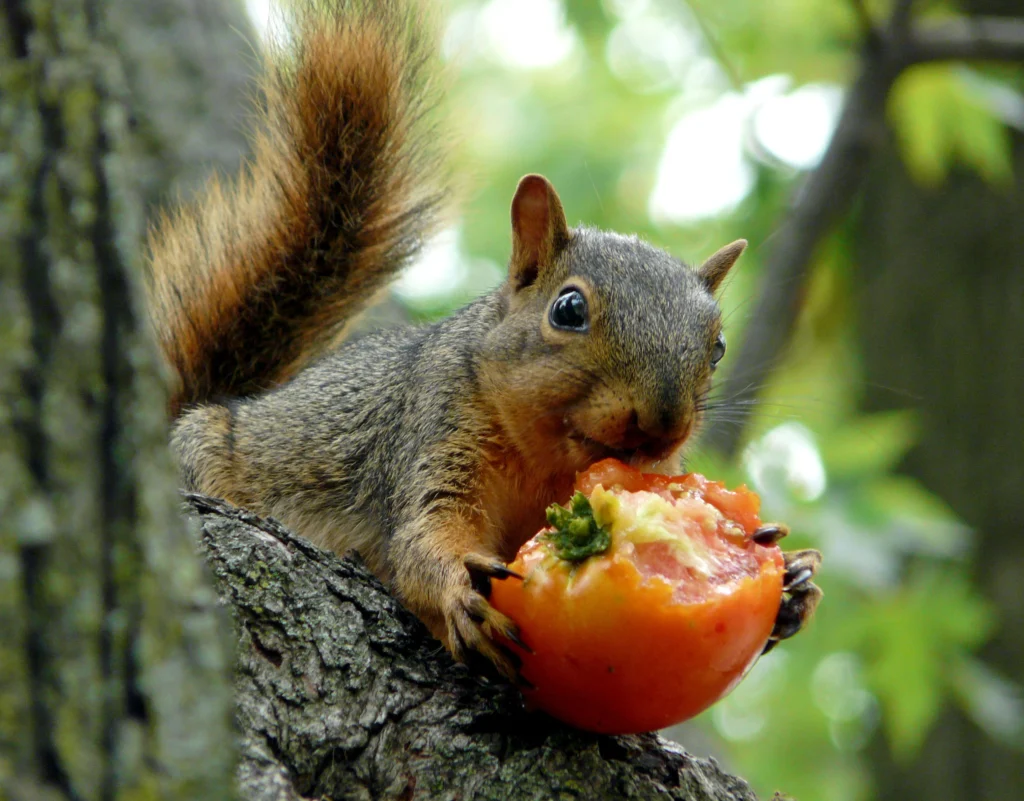
Before implementing deterrent strategies, it is important to understand squirrel behavior:
- Food-driven: Squirrels are primarily motivated by the search for food, including nuts, seeds, fruits, and garden vegetables.
- Curiosity and play: They investigate new objects and may damage plants out of curiosity.
- Nesting and caching: Squirrels dig holes to store food, which can disrupt garden beds.
- Agility and climbing: Squirrels can scale fences, trees, and walls with ease, making barriers more challenging.
By understanding these behaviors, gardeners can anticipate actions and deploy preventive measures more effectively.
Method 1: Physical Barriers
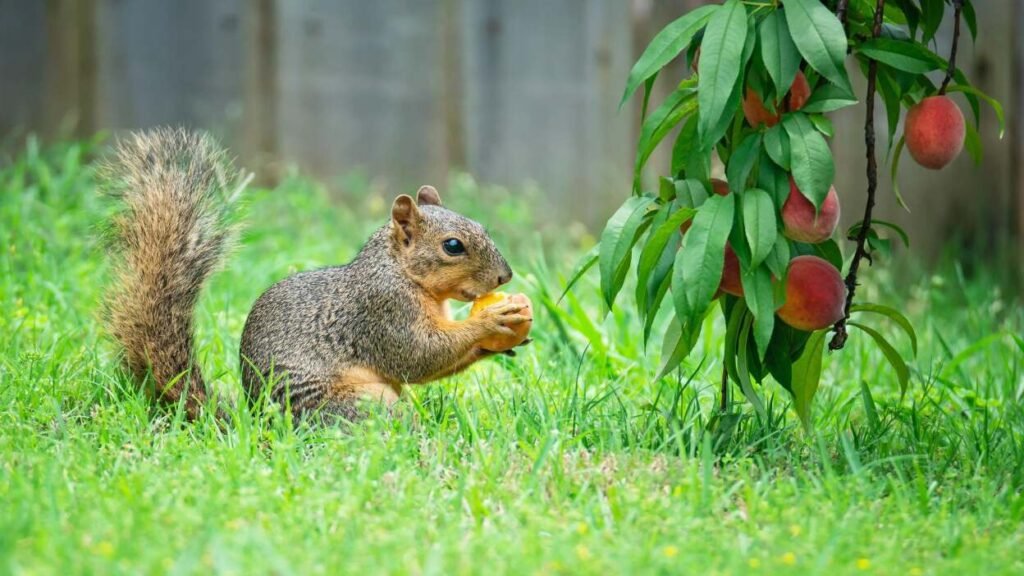
Physical barriers are the most reliable way to protect plants from squirrels.
Netting and Mesh
- Use wire mesh or hardware cloth to cover vegetable beds, fruit trees, and newly planted bulbs.
- Ensure mesh size is small enough to prevent squirrels from squeezing through.
- Secure edges to the ground with stakes to prevent digging underneath.
Tree and Plant Guards
- Wrap tree trunks with smooth metal or plastic collars to prevent climbing.
- Place protective tubes around saplings and bulbs to protect them during critical growth periods.
- Use cages or domes over high-value plants for extra security.
Physical barriers are especially effective when combined with other deterrents to increase overall protection.
Method 2: Motion and Noise Deterrents
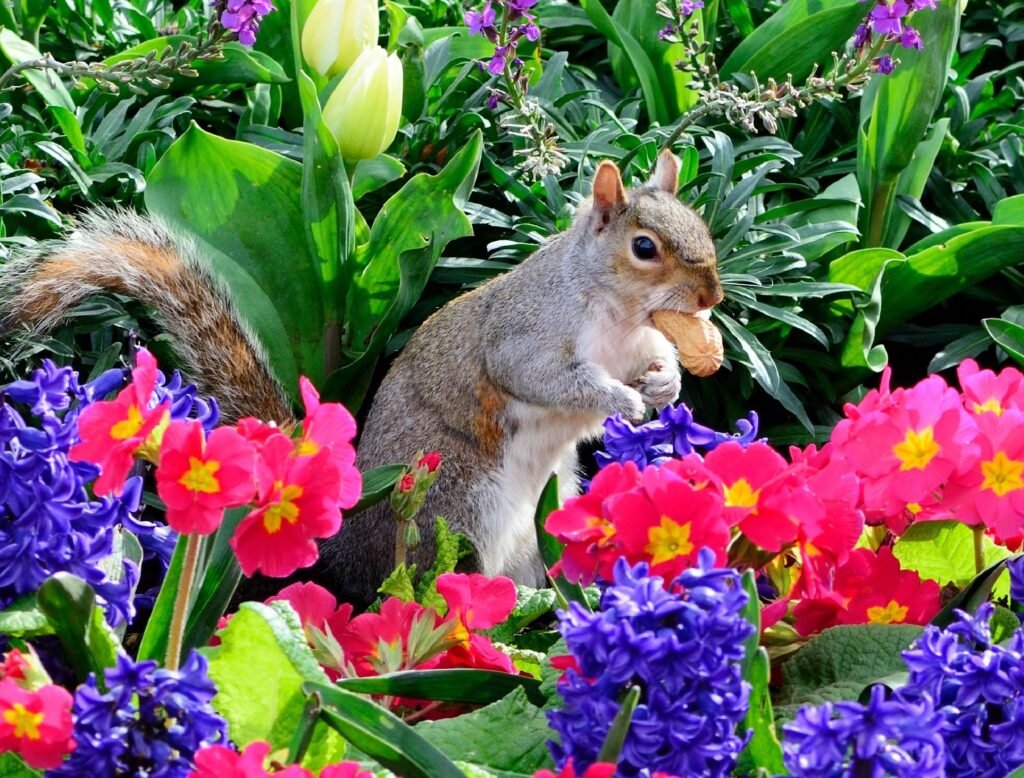
Squirrels are cautious animals, and sudden movements or noises can discourage them from frequenting your garden.
Motion-Activated Devices
- Install motion-activated sprinklers or lights near vegetable beds or fruit trees.
- The sudden spray of water or flashing light startles squirrels, encouraging them to avoid the area.
Noise Makers
- Use wind chimes, reflective tape, or aluminum pie plates to create unpredictable noises.
- Place these devices in areas where squirrels typically forage or climb.
Tips for Effectiveness
- Move devices occasionally to prevent squirrels from becoming accustomed.
- Combine with physical barriers for maximum deterrence.
Method 3: Repelling Scents and Natural Deterrents
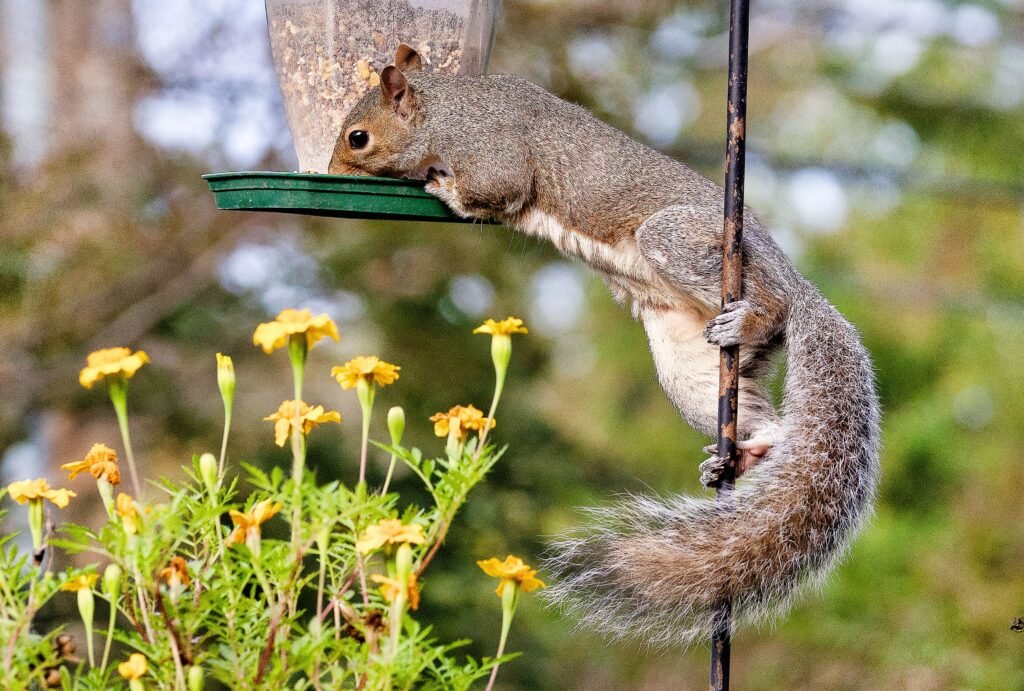
Certain scents naturally discourage squirrels without harming them.
Scent-Based Deterrents
- Peppermint oil: Soak cotton balls in peppermint oil and place them around garden beds or potted plants.
- Garlic or chili spray: Crush garlic or mix chili powder with water to create a natural spray for plants.
- Predator scents: Use commercially available predator urine (fox or coyote) to create the impression of danger.
Application Tips
- Reapply natural deterrents after rain or heavy watering.
- Combine scents with other methods, such as physical barriers, for better results.
- Avoid direct contact with edible produce when using sprays to prevent taste contamination.
Scent-based deterrents are eco-friendly and safe for children and pets.
Method 4: Garden Layout and Plant Selection
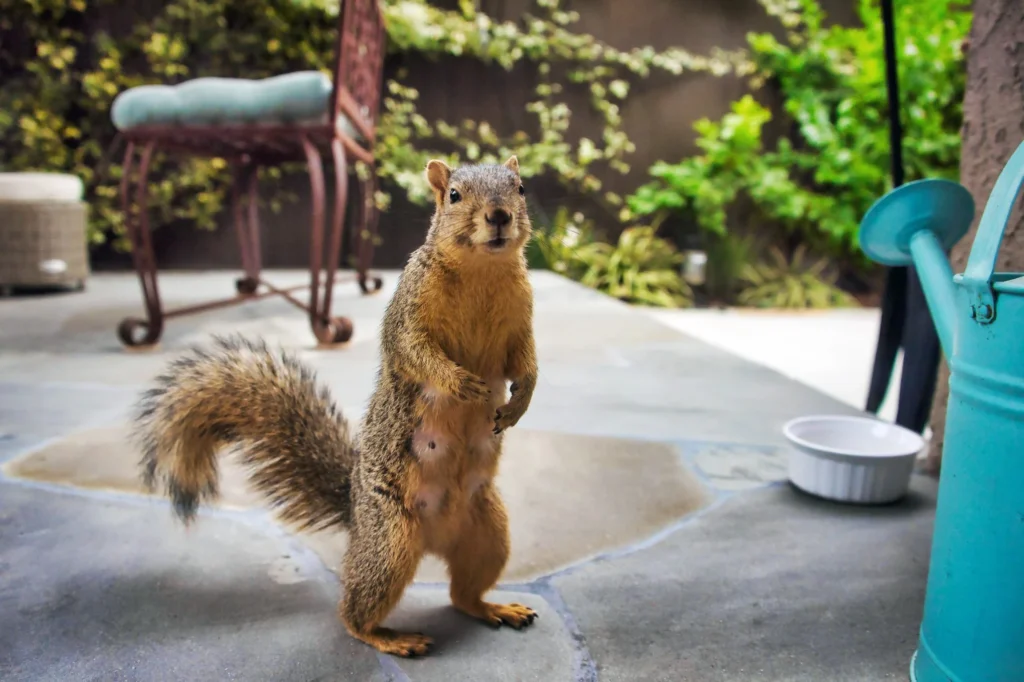
Strategic garden design can reduce squirrel activity by making access more difficult or less attractive.
Planting Strategies
- Use squirrel-resistant plants: Daffodils, alliums, lavender, and marigolds are generally avoided by squirrels.
- Create buffer zones: Plant these resistant species around high-value vegetables or fruit trees to discourage entry.
- Dense plantings: Crowding plants together reduces open space, making it harder for squirrels to navigate.
Mulching and Ground Cover
- Use prickly mulch, such as pine needles or thorny clippings, to discourage digging.
- Avoid loose soil that makes it easy for squirrels to bury or retrieve stored food.
Thoughtful garden layout reduces the risk of squirrel damage while enhancing aesthetics.
Method 5: Feeding Alternatives and Distraction
Providing squirrels with alternative food sources away from your garden can redirect their attention.
How to Implement
- Set up a squirrel feeder stocked with corn, sunflower seeds, or nuts in a location away from vegetables and fruit trees.
- Ensure feeders are regularly replenished to maintain interest.
- Include water sources, such as a small basin or bird bath, to attract squirrels away from high-value plants.
Benefits
- Reduces the pressure on your main garden crops.
- Allows squirrels to satisfy their foraging instinct safely.
- Can coexist with other wildlife if placed strategically.
Feeding alternatives are most effective when used in combination with barriers and deterrents.
Method 6: Human Presence and Active Management
Squirrels are highly responsive to human activity and can be discouraged through regular monitoring and engagement.
Active Management Practices
- Regular garden inspection: Check for signs of digging, chewed plants, or climbed trees.
- Remove fallen fruit promptly: Fallen fruits attract squirrels and encourage repeat visits.
- Harvest vegetables early: Prevents crops from becoming a target.
- Use scare tactics: Clap hands, toss water, or gently chase squirrels away when spotted.
Benefits
- Encourages squirrels to seek alternative areas for food.
- Minimizes long-term damage by discouraging repeated visits.
- Works well with other deterrent strategies to reinforce protection.
Common Mistakes to Avoid
- Assuming squirrels won’t climb fences: They are excellent climbers and can leap over low barriers.
- Leaving food accessible: Bird feeders or uncovered compost can attract squirrels.
- Relying on a single method: Squirrels adapt quickly, so combining multiple strategies is more effective.
- Ignoring signs of activity: Early intervention is easier and more successful than dealing with established habits.
- Using harmful chemicals: Chemical repellents can damage plants, harm wildlife, and pose risks to pets and children.
Avoiding these mistakes ensures a safer, more sustainable approach to squirrel management.
Benefits of Non-Chemical Squirrel Deterrence
Using chemical-free methods to deter squirrels offers several advantages:
- Eco-friendly: Protects soil, water, and beneficial insects.
- Safe for pets and children: Reduces risk of accidental poisoning.
- Sustainable: Provides long-term protection when used consistently.
- Promotes biodiversity: Allows coexistence with wildlife without harm.
- Cost-effective: Many natural deterrents and barriers are inexpensive and reusable.
By implementing multiple strategies, gardeners can maintain healthy, productive gardens without negatively impacting the surrounding ecosystem.
Conclusion
Squirrels can be persistent garden pests, but with non-chemical, proactive measures, gardeners can significantly reduce damage.
Key strategies include:
- Installing physical barriers such as netting, cages, and tree guards.
- Using motion-activated devices and noise deterrents to startle squirrels.
- Applying natural scents and sprays that repel squirrels.
- Designing gardens with resistant plants, buffer zones, and dense plantings.
- Providing feeding alternatives to redirect squirrels away from high-value crops.
- Actively monitoring and managing the garden to discourage repeat visits.
By combining these approaches, gardeners can protect vegetables, fruit trees, and ornamental plants without resorting to harmful chemicals. Non-toxic methods not only safeguard your crops but also promote a safe and harmonious outdoor environment, allowing squirrels and humans to coexist without conflict.
With consistent effort and thoughtful planning, it is possible to enjoy a flourishing, productive garden free from squirrel damage.
